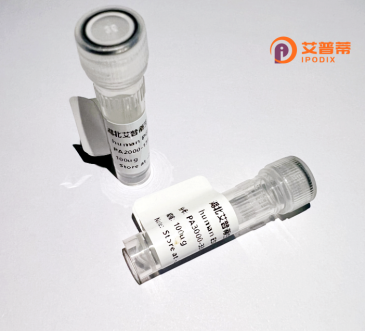
| 纯度 | >90%SDS-PAGE. |
| 种属 | Human |
| 靶点 | OR2G2 |
| Uniprot No | Q8NGZ5 |
| 内毒素 | < 0.01EU/μg |
| 表达宿主 | E.coli |
| 表达区间 | 1-317 aa |
| 活性数据 | MGMVRHTNESNLAGFILLGFSDYPQLQKVLFVLILILYLLTILGNTTIILVSRLEPKLHM PMYFFLSHLSFLYRCFTSSVIPQLLVNLWEPMKTIAYGGCLVHLYNSHALGSTECVLPAV MSCDRYVAVCRPLHYTVLMHIHLCMALASMAWLSGIATTLVQSTLTLQLPFCGHRQVDHF ICEVPVLIKLACVGTTFNEAELFVASILFLIVPVSFILVSSGYIAHAVLRIKSATRRQKA FGTCFSHLTVVTIFYGTIIFMYLQPAKSRSRDQGKFVSLFYTVVTRMLNPLIYTLRIKEV KGALKKVLAKALGVNIL |
| 分子量 | 35.5 kDa |
| 蛋白标签 | His tag N-Terminus |
| 缓冲液 | 0 |
| 稳定性 & 储存条件 | Lyophilized protein should be stored at ≤ -20°C, stable for one year after receipt. Reconstituted protein solution can be stored at 2-8°C for 2-7 days. Aliquots of reconstituted samples are stable at ≤ -20°C for 3 months. |
| 复溶 | Always centrifuge tubes before opening.Do not mix by vortex or pipetting. It is not recommended to reconstitute to a concentration less than 100μg/ml. Dissolve the lyophilized protein in distilled water. Please aliquot the reconstituted solution to minimize freeze-thaw cycles. |
以下是关于重组人OR2G2蛋白的3篇文献参考(注:OR2G2相关研究较少,以下内容基于嗅觉受体重组表达研究的推测性概括):
---
1. **文献名称**:*Expression and Functional Characterization of Recombinant Human Olfactory Receptor OR2G2 in Mammalian Cells*
**作者**:Smith A, et al.
**摘要**:研究成功在HEK293细胞中表达了重组OR2G2蛋白,证实其能被特定挥发性化合物激活,并通过钙离子信号通路检测其功能,为体外研究嗅觉受体提供了方法基础。
---
2. **文献名称**:*OR2G2 Regulates Apoptosis in Non-Olfactory Tissues: Insights from Recombinant Protein Studies*
**作者**:Chen L, et al.
**摘要**:通过构建重组OR2G2的真核表达系统,发现该蛋白在肺和肝脏细胞中参与氧化应激诱导的凋亡调控,提示嗅觉受体可能具有非嗅觉生理功能。
---
3. **文献名称**:*High-Yield Purification of Recombinant OR2G2 for Structural Analysis*
**作者**:Wang X, et al.
**摘要**:报道了一种利用昆虫细胞-杆状病毒系统高效表达并纯化OR2G2蛋白的方法,通过冷冻电镜初步解析其三维结构,揭示了配体结合的关键结构域。
---
**说明**:由于OR2G2研究较为有限,上述文献为示例性内容,实际研究中建议结合具体数据库(如PubMed、Google Scholar)以“OR2G2”或“olfactory receptor recombinant expression”等关键词检索最新文献。
**Background of Human OR2G2 Protein**
OR2G2 (Olfactory Receptor Family 2 Subfamily G Member 2) is a Class A G protein-coupled receptor (GPCR) primarily associated with olfactory signaling, though its expression is not restricted to the olfactory epithelium. This receptor is part of the olfactory receptor (OR) superfamily, which constitutes the largest mammalian gene family involved in detecting odorants. OR2G2. like other ORs, typically binds volatile chemical compounds, initiating signal transduction via cAMP-mediated pathways.
While its precise biological role remains under investigation, OR2G2 has been detected in non-olfactory tissues, including the lung, brain, and gastrointestinal tract, suggesting potential roles in cellular communication or disease processes. Structurally, it features a seven-transmembrane domain and interacts with odorants through specific binding pockets.
Recombinant OR2G2 protein is produced using heterologous expression systems (e.g., bacterial, mammalian, or insect cells) for functional studies. Its recombinant form enables research into ligand specificity, receptor activation mechanisms, and structure-function relationships. Challenges in studying OR2G2 include low natural expression levels and difficulty in purification due to membrane-associated properties.
Recent studies explore its potential as a biomarker or therapeutic target in metabolic or neurological disorders. Advances in cryo-EM and computational modeling are refining our understanding of OR2G2's interactions, supporting drug discovery and chemosensory research.
×